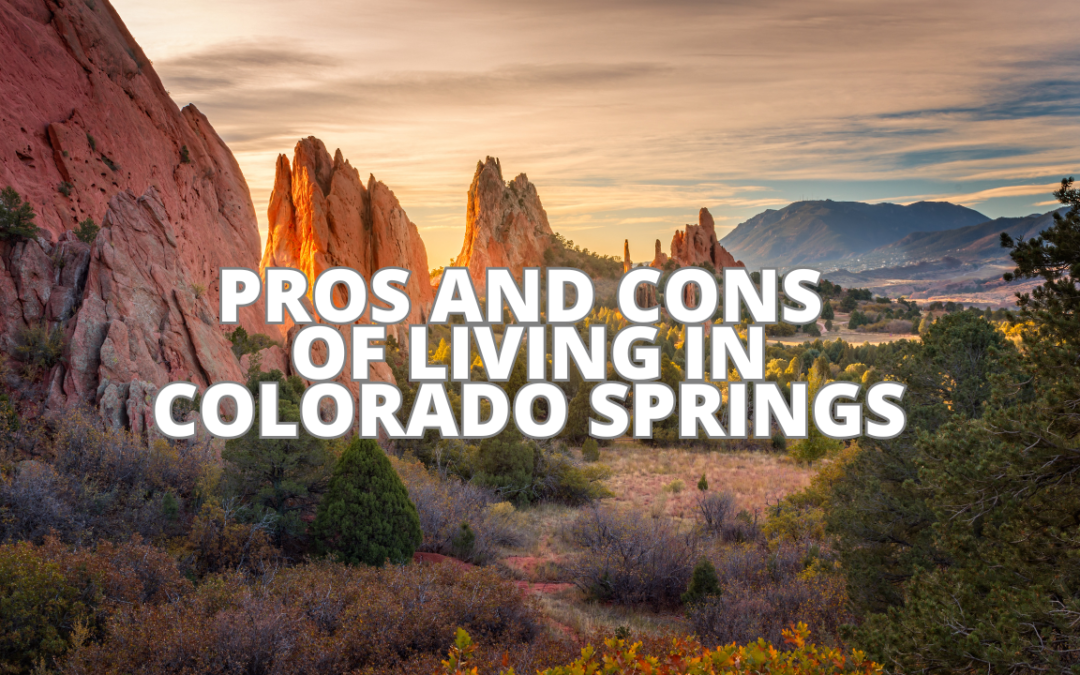Colorado Springs is a beautiful city located in the southern part of Colorado, nestled at the base of the Rocky Mountains. Known for its breathtaking natural scenery, outdoor recreation, and military presence, the city offers a unique lifestyle.
However, like any city, there are both pros and cons to living in Colorado Springs.
Pros:
- High Quality of Life: Excellent public schools, low unemployment rate, and year-round sunshine contribute to a high standard of living.
- Outdoor Recreation: Abundant opportunities for hiking, biking, skiing, and other outdoor activities.
- Beautiful Scenery: Stunning views of the Rocky Mountains and access to parks like Garden of the Gods.
- Good Air Quality: Clean air due to high elevation and low pollution levels.
- Strong Community: A strong sense of community with many religious and family-oriented activities.
Cons:
- High Housing Costs: Housing prices are relatively high compared to other cities in Colorado.
- Traffic Congestion: Traffic can be heavy during peak times, making commutes longer.
- Variable Weather: Unpredictable weather with significant snowfall in winter and occasional wildfires in summer.
- Limited Public Transportation: Residents often rely on cars due to minimal public transit options.
- Competitive Job Market: While the unemployment rate is low, job opportunities can be limited in certain fields.
In this blog post, we will delve deeper into the various aspects of life in Colorado Springs, exploring the geographic appeal, economic factors, residential life, cultural scene, climate and weather, health and wellness, transportation and accessibility, and safety and security. By the end, you’ll have a thorough understanding of what it’s like to live in this picturesque city.
“`
Geographic Appeal
Colorado Springs is a city located in the eastern foothills of the Rocky Mountains, which provides a stunning mountainous landscape. The city is situated at an elevation of 6,035 feet (1,839 meters) above sea level, making it one of the highest cities in the United States. The mountainous terrain offers breathtaking views from different parts of the city.
Mountainous Landscape
The city’s location in the foothills of the Rocky Mountains provides a unique and picturesque landscape. The towering mountains offer a stunning backdrop to the city’s skyline. The city is surrounded by several mountain ranges, including the Rampart Range, the Cheyenne Mountain Range, and the Palmer Divide. The mountains also provide a natural barrier that protects the city from severe weather conditions, such as tornadoes and hurricanes.
Outdoor Recreation Opportunities
The mountainous terrain of Colorado Springs offers numerous outdoor recreation opportunities. The city has over 9,000 acres of parkland, with more than 500 parks and 150 miles of trails. The city’s most popular park is the Garden of the Gods, which features towering red rock formations that attract visitors from around the world. The park offers several hiking trails, rock climbing, and mountain biking opportunities.
Other outdoor recreation opportunities in the city include skiing, snowboarding, and snowshoeing in the nearby mountains during the winter months. The city also has several lakes and reservoirs that provide opportunities for fishing, boating, and swimming.
In conclusion, Colorado Springs’ location in the foothills of the Rocky Mountains provides a unique and picturesque landscape that offers numerous outdoor recreation opportunities. The mountainous terrain provides a natural barrier that protects the city from severe weather conditions and offers breathtaking views from different parts of the city.
Economic Factors
Job Market
Colorado Springs has a diverse economy with job opportunities in various sectors such as healthcare, technology, military, and tourism. The city has a low unemployment rate of 2.8% as of May 2024, which is lower than the national average of 3.6% source. The top employers in the city include Fort Carson, Peterson Air Force Base, and the United States Air Force Academy. Additionally, Colorado Springs is home to several major companies such as Lockheed Martin, Oracle, and Hewlett-Packard.
Cost of Living
The cost of living in Colorado Springs is lower than the national average. According to Citytistics, the cost of living index in Colorado Springs is 94.6, which is lower than the national average of 100. Housing costs in Colorado Springs are also lower than the state average. The median home price in Colorado Springs is $374,000, while the median rent for a two-bedroom apartment is $1,500 per month source. The city also has a lower sales tax rate compared to other major cities in the state, which is 8.25%.
Overall, the job market in Colorado Springs is diverse and the unemployment rate is low. The cost of living in the city is lower than the national average and housing costs are affordable.
Residential Life
Neighborhood Diversity
Colorado Springs is a diverse city with a wide range of neighborhoods to choose from. Each neighborhood has its own unique character and amenities. The city has a mix of urban and suburban areas, with many neighborhoods offering a small-town feel. Some of the most popular neighborhoods in Colorado Springs include Old Colorado City, Manitou Springs, and Downtown.
Old Colorado City is a historic area known for its Victorian architecture and charming shops and restaurants. Manitou Springs is a quirky mountain town with a vibrant arts scene and natural mineral springs. Downtown Colorado Springs is the bustling heart of the city, with a variety of shops, restaurants, and entertainment options.
Education and Schools
Colorado Springs has a good selection of public and private schools, including several top-rated schools. The city is home to the University of Colorado Colorado Springs and Colorado College, both of which are highly regarded institutions of higher learning.
The public school system in Colorado Springs is served by School District 11, which operates over 60 schools in the area. The district is known for its strong academic programs and innovative teaching methods. In addition, there are several private schools in the area, including Fountain Valley School and Colorado Springs School.
Cultural Scene
Colorado Springs has a thriving cultural scene, with a variety of museums, galleries, and theaters. The Colorado Springs Fine Arts Center is a popular destination for art lovers, with a collection of over 20,000 works of art. The city is also home to the Colorado Springs Pioneers Museum, which showcases the history of the region.
For theater lovers, the Colorado Springs TheatreWorks is a must-visit. The theater company produces a variety of plays and musicals throughout the year. The city also hosts several cultural events and festivals, including the Colorado Balloon Classic and the Colorado Springs Oktoberfest.
Climate and Weather
Sunny Days
Colorado Springs is known for its sunny weather, with over 300 days of sunshine per year. This makes the city an ideal location for outdoor activities such as hiking, biking, and skiing. The sunny weather also contributes to the city’s reputation as a healthy and active community.
Variable Seasons
While the sunny weather is a positive aspect of living in Colorado Springs, the city’s climate can also be unpredictable. The city experiences a wide range of temperatures and weather conditions, often within the same day. This unpredictability can make it challenging to plan outdoor activities and can be a source of frustration for those who prefer more consistent weather patterns.
The city’s location in the Rocky Mountains also means that it can experience significant snowfall during the winter months, which can make driving and commuting difficult. However, the city is equipped to handle snow removal and has a variety of winter sports and activities available for residents to enjoy.
Overall, the climate and weather in Colorado Springs can be both a positive and negative aspect of living in the city. While the sunny days are a major draw for outdoor enthusiasts, the variable seasons can be a challenge for those who prefer more consistent weather patterns.
Health and Wellness
Access to Healthcare
Colorado Springs has a variety of healthcare options available for its residents. The city is home to several hospitals, including the UCHealth Memorial Hospital and Penrose-St. Francis Health Services. There are also numerous urgent care centers and clinics throughout the city. In addition, Colorado Springs has a high number of healthcare providers per capita, making it easier for residents to find a doctor or specialist.
Active Lifestyle
Living in Colorado Springs provides ample opportunities for an active lifestyle. With over 300 days of sunshine each year, residents can enjoy outdoor activities year-round. The city is surrounded by the Rocky Mountains, providing access to hiking, skiing, and other outdoor activities. Additionally, Colorado Springs has over 100 parks and open spaces, making it easy to find a place to exercise or relax outdoors.
The active lifestyle in Colorado Springs is not just limited to outdoor activities. The city has a variety of fitness centers, yoga studios, and other wellness facilities. Residents can also participate in organized sports leagues, such as soccer, basketball, and volleyball.
Living an active lifestyle can have numerous health benefits, including reducing the risk of chronic diseases such as diabetes and heart disease. Colorado Springs’ focus on health and wellness makes it an ideal place for those looking to prioritize their physical and mental well-being.
Transportation and Accessibility
Colorado Springs offers a variety of transportation options for its residents, but it is not known for its public transportation system. The transit score is 19, which means that there is minimal transit available Redfin. However, the city offers several bus routes, and the Mountain Metropolitan Transit system provides public transportation to the surrounding areas.
Driving is the most common way to get around Colorado Springs, and the city has a well-maintained road system. Traffic can be heavy during rush hour, but it is generally not as congested as larger cities. The city is also bike-friendly, with many bike lanes and trails throughout the area.
Colorado Springs is home to the Colorado Springs Airport, which offers flights to several major cities in the United States. The airport is located just six miles southeast of downtown Colorado Springs and is easily accessible by car or public transportation.
Overall, Colorado Springs is a relatively accessible city, but residents should be prepared to rely on a car to get around.
Safety and Security
When it comes to safety and security, Colorado Springs is a relatively safe city. The crime rate is lower than the national average, and violent crime is less common than property crime. According to NeighborhoodScout, the city’s crime rate is 33 per 1,000 residents, which is lower than 85% of U.S. cities.
However, like any city, there are areas that are safer than others. The downtown area, in particular, has a higher crime rate than other parts of the city. It’s important to be aware of your surroundings and take precautions to stay safe, such as not walking alone at night and keeping your valuables out of sight.
The city has a well-equipped police department that is committed to keeping the community safe. The police department has a strong presence in the community and is responsive to residents’ concerns. There are also several neighborhood watch programs throughout the city that help to keep communities safe and prevent crime.
Overall, Colorado Springs is a relatively safe city with a low crime rate. While there are areas that are safer than others, residents can take steps to stay safe and secure. The city’s police department is committed to keeping the community safe, and there are several neighborhood watch programs that help to prevent crime.
Pros of Living in Colorado Springs
Colorado Springs is a city with a lot of natural beauty and outdoor recreational opportunities. Here are some of the pros of living in Colorado Springs:
Outdoor paradise
Colorado Springs is a haven for outdoor enthusiasts, with its proximity to the Rocky Mountains and numerous hiking trails, rock climbing spots, and biking paths. Residents can enjoy the stunning natural beauty of Garden of the Gods, Pikes Peak, and Red Rock Canyon Open Space, offering activities such as hiking, camping, rock climbing, and mountain biking. The city also has a high number of parks and open spaces, making it easy for residents to enjoy the outdoors.
Low Cost of Living
The cost of living in Colorado Springs is relatively low compared to other cities in Colorado. The average rent prices are just over $1,500, while housing prices are about 4% lower than the rest of Colorado. The region’s cost of living is approximately 13% lower than in other areas, making it an affordable place to live.
Good Public Schools
Colorado Springs has many excellent public schools that provide quality education to students. According to The Honest Local, the city’s public schools are some of the best in the state, with a high graduation rate and a low student-to-teacher ratio. The city also has several renowned universities, including the University of Colorado, Colorado College, and the United States Air Force Academy.
Year-Round Sunshine
Colorado Springs has over 300 days of sunshine each year, making it an ideal place for those who love the outdoors. The city has a dry climate, which means that residents can enjoy outdoor activities year-round without worrying about rain or humidity. The sunny weather also makes it a great place to grow crops, and many residents have backyard gardens.
Good Air Quality
Colorado Springs has some of the cleanest air in the country, thanks to its high elevation and low levels of pollution. The city has a low smog rating and is free from the air pollution that plagues many other cities. The clean air makes it a great place for outdoor activities and also contributes to a healthy lifestyle.
Cons of Living in Colorado Springs
While Colorado Springs has many great qualities, there are also some downsides to living in this city. Here are some of the cons to consider before deciding to move to Colorado Springs.
High Cost of Living
One of the biggest cons of living in Colorado Springs is the high cost of living. According to The Honest Local, the cost of living in Colorado Springs is 8% higher than the national average. Housing costs, in particular, can be quite high, with the median home price in Colorado Springs being $350,000 as of 2021. This can make it difficult for some people to afford to live in the city.
Traffic Congestion
Another downside of living in Colorado Springs is the traffic congestion. The city has experienced rapid growth in recent years, which has led to increased traffic on the roads. Rush hour traffic can be particularly bad, with long commutes and frequent delays. According to Apartment Guide, the average commute time in Colorado Springs is 23 minutes, which is slightly higher than the national average.
Harsh Weather
While Colorado Springs is known for its beautiful scenery and outdoor recreation opportunities, the weather can be harsh at times. The city is located at a high altitude, which means that temperatures can be quite cold in the winter months. Snowstorms are not uncommon, and the city can experience heavy snowfall at times. Additionally, the city is prone to wildfires during the summer months, which can be a serious concern for residents.
Limited Job Opportunities
Finally, Colorado Springs may not be the best place for those looking for job opportunities. While the city has a low unemployment rate, according to Vittana.org, the job market can be competitive, and there may be limited opportunities in certain fields. This can make it difficult for some people to find work in the city, particularly if they have specialized skills or experience.
Frequently Asked Questions
What are the advantages and disadvantages of the climate in Colorado Springs?
Colorado Springs has a semi-arid climate with low humidity and mild winters. The city enjoys over 300 days of sunshine each year, which is a major advantage for those who love outdoor activities. However, the city also experiences occasional hailstorms, thunderstorms, and wildfires during the dry season. The summers can be hot, and the winters can be cold, with occasional snowstorms.
How does the cost of living in Colorado Springs compare to other similar-sized cities?
The cost of living in Colorado Springs is relatively low compared to other similar-sized cities. The city has a lower cost of living index than the national average, with affordable housing, groceries, and transportation costs. However, healthcare and utility costs are slightly higher than the national average.
What should potential residents know about the housing market in Colorado Springs?
The housing market in Colorado Springs is competitive, with a low inventory of homes for sale and high demand. The median home price is slightly lower than the national average, but it has been increasing in recent years. The city offers a variety of housing options, including apartments, townhouses, and single-family homes.
Can young professionals find ample career opportunities in Colorado Springs?
Colorado Springs is home to several large employers, including the military, healthcare, and technology industries. The city has a growing startup scene, with several coworking spaces and incubators. However, the job market can be competitive, and some young professionals may need to commute to nearby cities for job opportunities.
What are the public transportation options like in Colorado Springs?
Colorado Springs has a limited public transportation system, with a bus system operated by Mountain Metropolitan Transit. The city does not have a light rail system or commuter rail system. Many residents rely on personal vehicles to get around the city.
What are the safety and crime rates in the neighborhoods of Colorado Springs?
Colorado Springs has a lower crime rate than other similar-sized cities. However, like any city, there are neighborhoods with higher crime rates. Potential residents should research the crime rates of specific neighborhoods before choosing a place to live. The city has a strong police force and community policing programs to help keep residents safe.



